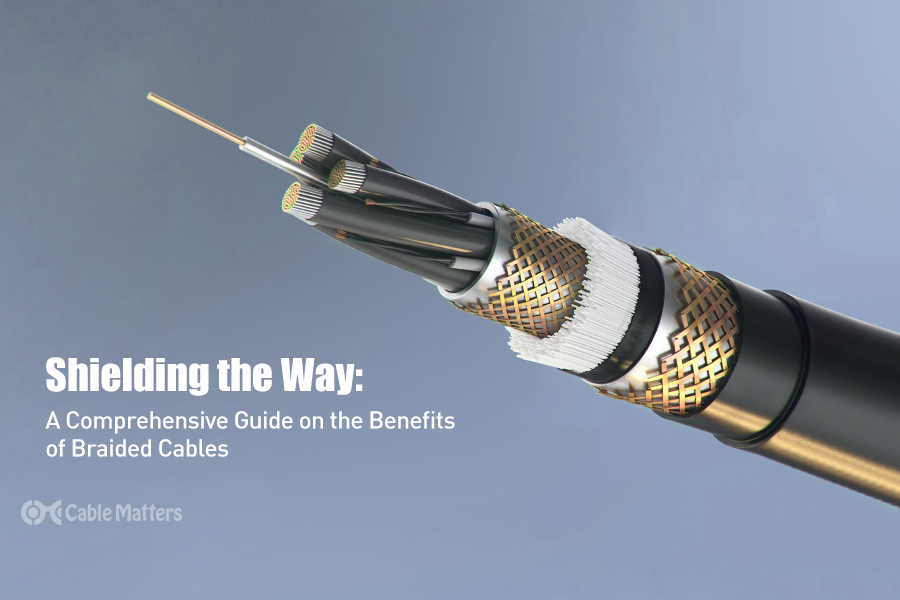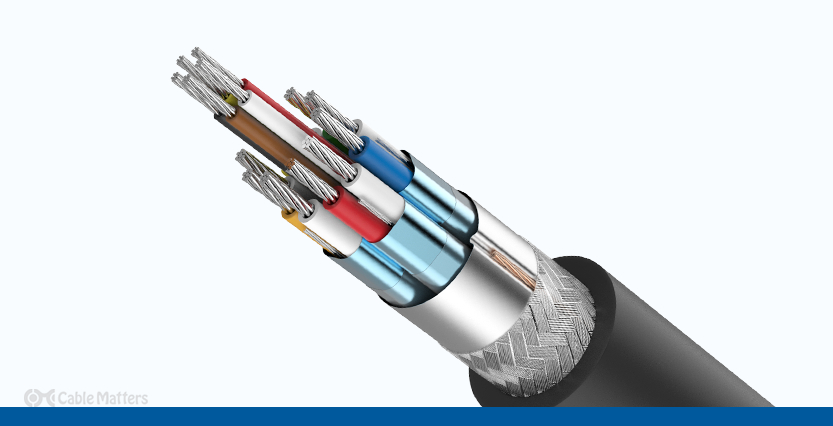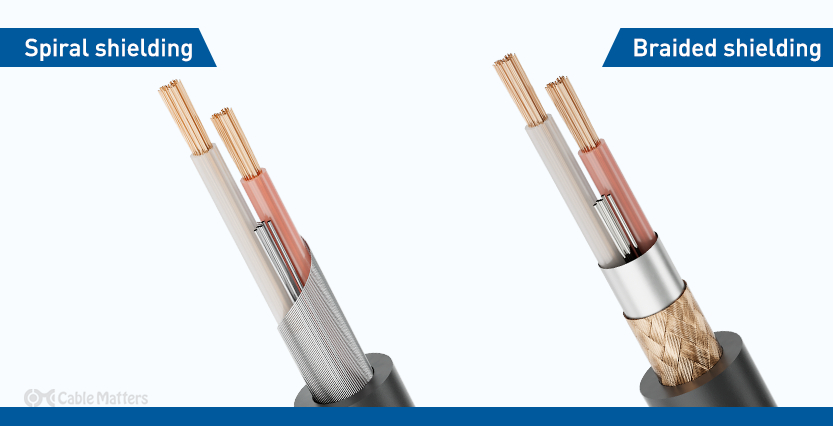
Braided cables offer an important layer of protection against electromagnetic interference (EMI) and often go hand in hand with other protective technologies, like foil wrappings, and cable splines. Braiding comes in a range of different materials and styles, with each focusing on a different type of shielding, though they all display the clear benefits of braided cables. Some offer physical protections against external damage as well as EMI shielding, while others are much more focused on protecting against signal noise and crosstalk between cables that run alongside one another.
Some cable braid is merely a nylon mesh designed to hold collections of wires together. You'll find that on many internal computer components, but specifically power supply cables, as well as some consumer cables like high-end USB and HDMI cables. A more important cable braid, however, is the one you'll find underneath the outer silicon coating on external cables, like Ethernet cables. That braiding is made from metallic strands that are threaded together. It can be made of a range of different materials, depending on the design of, or needs of, the braiding.
Cable braiding was originally invented in the 1800s to help insulate early telegraph and electrical wires entering the home and businesses. Where early attempts at shielding involved wrapping grounding wires around bare wires, a more effective solution was required.
Early telephone operators discovered that a flattened wire wrapped around a cotton or flax core proved to be an effective solution for insulating telephone wires against radio interference. The benefits of braided cables were immediately clear. Braiding then evolved from there to be a more effective, more affordable, and more versatile solution to the ever-increasing need for shielding in our ever-more-connected world.
What are Braided Cables?
Braided cables come in many different shapes, sizes, and styles. While you can describe any cable with a mesh layer as being “braided,” in this instance, we’re looking specifically at cables wrapped in a metallic braid to improve their EMI shielding. The braid is made from fine metallic strands that are tightly woven together to make a meshed cylindrical construction around the internal wires.

The purpose of any cable shielding is to prevent interference from external sources disrupting the signal traveling down the internal wire. Using twisted pair copper wiring helps eliminate some of the interference from radiowaves, but electromagnetic interference from other devices and other wiring is still a problem. That’s where shielding in the form of foil wraps and metallic braiding come in.
A braid is typically fitted around the collection of twisted pair wires, providing an internal sheath layer underneath the external silicon coating. This braid is typically made from tinned copper and silver-plated copper, but it can also be made from pure silver, pure nickel, nickel-plated copper, gold-plated copper, gold alloys, monel, and bronze.
The type of braided shielding used in a braided cable will depend on the cable type, its cost, planned implementation, and its original design purpose.
Benefits of Braided Cables
The main benefits of braided cables are related to shielding. Having a metallic braid within a cable helps it ward off interference from radiowaves and electromagnetic interference, and just as crucially, reduces the electromagnetic interference put out by that cable itself. This helps improve the signal integrity of not only the cable the braid is protecting, but in all other nearby cables and devices, too.
This ensures that whatever data or signal you’re sending down that cable is going to get to the other end as free from interference as possible. This is particularly important if you’re sending lots of data frequently, or if the data is sensitive; Especially if the cable will be operating in a busy environment with lots of connected devices and other cabling.

That’s not the only benefit of braided cables, though. That additional metallic mesh layer adds extra physical durability to the cable, making it more able to resist flexing and bending, as well as offering better protection against physical damage from external sources. The downside of that is that it does make the cable thicker and heavier, and less malleable, which can make installation – particularly within walls or round tight corners – a little trickier to manage.
Comparison With Other Types of Cables
While the benefits of braided cables are clear, they’re not the only option when it comes to shielding cables. Many cable types also offer foil wrap shielding, which can be placed around the individual twisted copper pairs, as well as around the entire collection of twisted pairs – much like most braided cable solutions.
Foil wrapping offers greater protection against electromagnetic interference than braiding alone, but it doesn’t give the cable much additional rigidity and is prone to tearing which can reduce or even eliminate the shielding it offers. The most heavily-shielded cables can come with foil-wrapped twisted pairs and an additional braided mesh around them all, offering a dual layer of protection.
Another alternative shielding solution to braided cables are spiral shields. These are cables with spiraled strands of copper that run parallel to the twisted pairs. This is both cheaper and easier to manufacture than mesh braiding, so tends to be used more often in cheaper cables. Spiral shielding doesn’t give the cable the same rigidity, however, so that does make it lighter, easier to transport, and easier to install, but it does make spiral shielding cables more susceptible to damage.

Spiral shielded cables also have more gaps in the shielding than braided cables, so that can allow electromagnetic interference to leak through if additional shielding isn’t available.
Older cables, like Cat 5 Ethernet cables, will often be made without any additional shielding like braiding or foil wrapping. These are just twisted pair cables, which do have some protection against external interference, though mostly radio waves rather than electromagnetic. That makes them perfectly adequate for at-home use or in offices where there aren’t many connected devices – although you should really replace yours with something better.
As homes and businesses continue to expand with more and more devices, though, these kinds of older cables will become less able to protect their data and prevent their own interference from leaking out.
Fiber optic cables are some of the most robust for networking and various other means. They offer the greatest signal strength over longer distances, with the glass strands at their core able to prevent signal attenuation over much greater distances. Some fiber optic cables can run for over 100 miles without losing the signal. To achieve this, however, fiber optic cables need to offer excellent shielding.
Fiber optic cables can be designed with a loose tube design, where the fibers are enclosed in a protective tube, typically with a water-resistant gel. They can also be tight buffered, where the cables are given an extra waterproofing layer to further protect them against the elements.
Fiber optic cables designed to run underground can also be fitted with additional armoring in the form of corrugated steel tape. This provides additional compressive strength to the cable, making it more resistant against physical damage – especially against crushing. It also gives the cable a thick protective layer against rodent damage.
How To Choose the Right Braided Cable
Once you’ve weighed up the benefits of braided cables, it’s time to decide whether a braided cable is for you, and whether you want additional shielding as well. Braided cables without any more shielding offer excellent protection against external radio and electromagnetic interference, with their combination of the braid and internal twisted copper pair.
However, if you want even greater protection, opting for a cable with both a braided layer and internal foil wrapping will go even further. Those cables offer a near-100% protection against electromagnetic interference and are physically more durable thanks to the braiding. Some cables even offer foil wrapping of the individual copper pairs, and both braided and foil wrappings of the collection of wires.
For the ultimate in protection, look for cables with all of those layers, as well as an internal spline. That plastic divider separates out the individual twisted pairs helping eliminate crosstalk, as well as providing additional rigidity to the cable and extra protection against compression damage.
Make sure when you’re buying braided cables, however, that you’re getting a real mesh braid and not a spiral shield. While both use metallic layers to add additional shielding to a cable, braids are more effective and more comprehensive, offering better overall protection for the internal wiring, although they do tend to be more expensive.
Conclusion
The benefits of braided cables are clear: They’re stronger against external damage, are more resistant to damage during installation, and they offer excellent protection against electromagnetic and radio interference. That goes for outside sources, and the cable itself – preventing it from broadcasting its own interference to other cables.
Braiding isn’t a complete shielding solution by itself, though. You’ll need to buy a cable with braiding and foil shielding to completely protect against EMI and other interference. You also need to factor in the additional rigidity of braided cables, and how that can make installation more costly and more complicated.